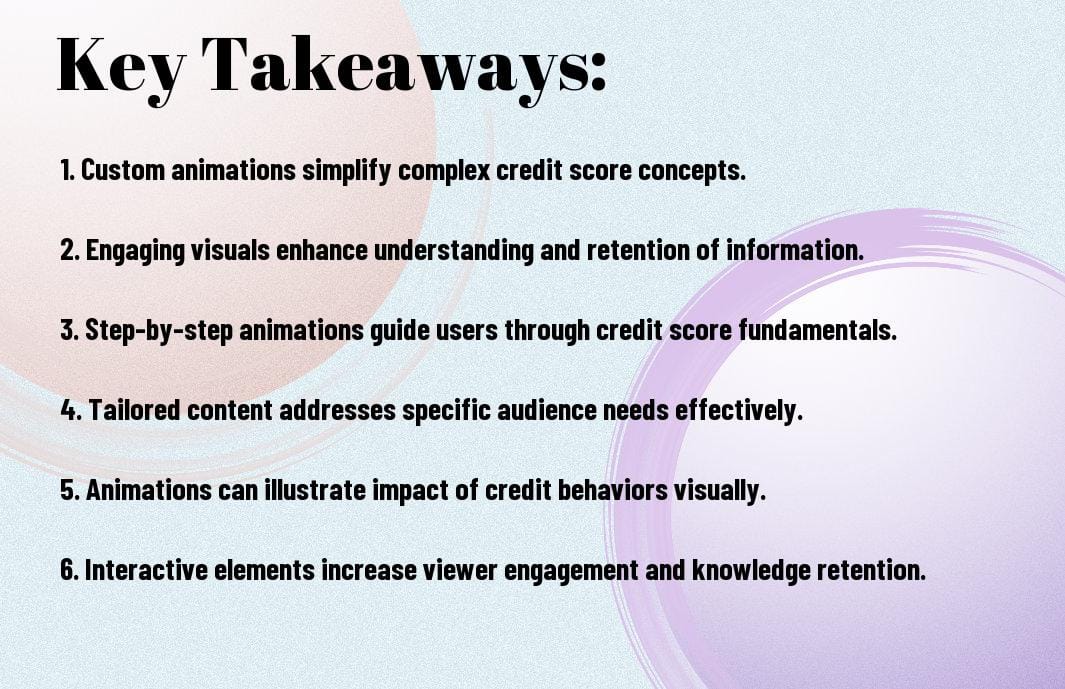Scores play a vital role in your financial journey, influencing your ability to secure loans, credit cards, and even housing. With the help of custom animation services, you can easily grasp the complexities of credit scores and how they affect your financial decisions. This guide offers you a step-by-step approach to understanding your credit score, highlighting both the positive impacts of maintaining a good score and the risks associated with a low score. Let’s dive in and empower you to take control of your credit health!
Key Takeaways:
- Custom Animation Services enhance comprehension of complex topics like credit scores, making it easier for viewers to grasp the material.
- Step-by-Step Approach breaks down information into manageable parts, fostering a clear understanding of the factors that affect credit scores.
- Engagement through visual storytelling increases retention, allowing viewers to better recall and apply knowledge about credit scores in their financial decisions.
What is a Credit Score?
For individuals seeking to understand their financial health, a credit score serves as a vital metric. It reflects your creditworthiness based on your financial behavior, including how responsibly you manage debt. A better understanding of credit scores can empower you to make informed financial decisions and access better loan options.
Definition and Importance
The credit score is a numerical representation of your credit health, typically ranging from 300 to 850. A higher score indicates lower risk to lenders, making it vital for loan approval, favorable interest rates, and renting properties. Your score influences significant financial decisions throughout your life.
Factors Influencing Credit Scores
One major aspect that affects your credit score includes:
- Payment History
- Credit Utilization
- Length of Credit History
- Types of Credit
- New Credit Inquiries
Assume that understanding these factors helps you maintain or improve your score, enabling better financial opportunities.
Further analyzing each factor provides greater clarity on how to manage your credit effectively. Your payment history holds substantial weight as late payments significantly impact your score. Additionally, maintaining a low credit utilization ratio demonstrates responsible credit usage. The longer your credit history, the better it reflects on your score, whilst having diverse types of credit can boost it. Lastly, too many new credit inquiries can signify risk. Assume that a balanced approach toward these elements maximizes your credit score potential.

The Role of Animation in Financial Education
Some may underestimate the power of animation in financial education, but it serves as an effective tool for simplifying complex topics. By utilizing MyCredit Guide FICO® Score & Experian® Credit Report, you can learn about your credit score in a way that feels engaging and accessible. Animation can make the learning process more enjoyable and retainable, ultimately helping you make informed financial decisions.
Enhancing Understanding
Enhancing your grasp on financial concepts is easier with animation. This medium breaks down intricate information into digestible segments, allowing you to absorb and comprehend details about your credit score and its impact on your financial health.
Engaging Visuals
Enhancing your financial education experience is largely due to engaging visuals that animation provides. You’ll find that colorful images, interesting characters, and lively sequences capture your attention, making learning about credit scores less intimidating.
This dynamic approach not only captures your interest but helps you relate to the content. By illustrating scenarios like how timely bill payments can improve your credit score, or how late payments can negatively affect it, you gain a visual representation of the positive and negative consequences of your financial behaviors. Such clear depictions help you connect your actions to their repercussions, making it easier to navigate your financial journey.
Benefits of Custom Animation Services
Once again, leveraging custom animation services offers numerous advantages for explaining complex concepts. These animations not only facilitate understanding but also make learning enjoyable and engaging. By utilizing visual storytelling, you can effectively capture your audience’s attention, translating intricate financial principles into memorable and relatable narratives that resonate with your viewers.
Tailored Content
Before submerging into custom animation, consider how it allows for the creation of tailored content that speaks directly to your audience’s needs. You can outline your key messages and convey them in a way that aligns with your viewers’ interests, ensuring they receive information that is relevant and engaging.
Improved Retention
On the flip side, custom animations significantly boost information retention. By presenting your content visually, you help create a multi-sensory learning experience that is easier for your audience to grasp and remember.
For instance, studies have shown that people are more likely to recall information presented in an animated format. This approach leverages visual elements and storytelling techniques, which enhance cognitive processing, allowing you to effectively communicate even complex ideas. By incorporating engaging animations, you not only increase the chances that your audience will retain vital information about credit scores but also foster a deeper understanding of their significance in financial health. This leads to greater confidence and informed decision-making regarding their credit journeys.

Step-by-Step Process to Create Animated Content
All aspects of creating animated content involve thoughtful planning and execution. You should understand each phase to ensure your message about How Is My Credit Score Calculated? is effectively conveyed. Below is a summary of the important steps involved:
| Step | Description |
|---|---|
| 1 | Concept Development |
| 2 | Storyboarding and Design |
Concept Development
Any project starts with concept development, where you refine your ideas into a clear message. This phase is critical as it sets the foundation for your animation. Discuss your goals and the target audience, focusing on making the complex topic of credit scores relatable and engaging.
Storyboarding and Design
Between concept development and final animation, storyboarding and design play a significant role. You sketch the animation sequence, visualize scenes, and ensure that your narrative flows smoothly. This stage transforms your ideas into a detailed plan, incorporating visuals that complement your message.
Also, this phase allows you to assess the visual style, color palette, and animation techniques best suited for your audience. Make choices that reflect your brand while ensuring the content remains accessible. By blending creativity with strategic design, you can effectively communicate the positive and negative aspects of credit scores while engaging viewers.

Using Animation to Explain Credit Scores
Many people find credit scores to be an intricate and confusing topic. However, using animation can effectively demystify the subject, helping you understand the key components that influence your creditworthiness. With visually engaging content, you can grasp how factors such as payment history, credit utilization, and length of credit history impact your score, all in a way that is easy to digest and retain.
Simplifying Complex Information
Beside providing entertainment, animation serves as a powerful tool for simplifying complex information. By breaking down difficult concepts into bite-sized, visually appealing segments, you can more easily understand how various elements contribute to your credit score. This clarity empowers you to make informed decisions regarding your financial health.
Real-World Applications
At the same time, animation demonstrates real-world applications of credit scores in your everyday life. From obtaining loans to understanding interest rates, your credit score plays a significant role in financial transactions. Visual representations can help you foresee how your actions affect your score, allowing for proactive management.
Scores have a direct effect on your financial opportunities, influencing decisions like loan approvals, interest rates, and even job applications. By using animated content to represent these real-world scenarios, you can visualize how a good credit score opens doors, while a poor one can limit your options. Through animation, you gain insight into strategies for maintaining or improving your score, such as timely bill payments and managing credit card balances. Ultimately, this understanding enables you to navigate your financial landscape with confidence.
Measuring the Effectiveness of Animation for Learning
After implementing custom animation services to illustrate credit scores, you should evaluate their effectiveness in enhancing comprehension and retention. Animated content can make complex information more digestible, helping you visualize and better understand critical concepts surrounding credit scores. Regular assessments allow you to gauge learner engagement and knowledge acquisition, ensuring you are on the right educational track.
Feedback and Assessment
On collecting feedback from your audience, you will gain invaluable insights into how well they grasp the animated content. Surveys, quizzes, and discussions can provide qualitative and quantitative data that highlight areas of success and those that may require improvement. This feedback loop is crucial for tailoring your animations to meet learner needs.
Adjusting Strategies
Across your evaluations, you might discover particular themes or topics where learners struggle or excel. It’s crucial to adapt your content and delivery strategies based on this feedback, optimizing future animations to target identified gaps in understanding.
Further, leveraging adjustments not only improves your current animations but also ensures that your future projects remain relevant and effective. You might consider revising visuals or simplifying explanations for complex topics that receive lower comprehension scores. Additionally, integrating interactive elements can enhance engagement, making learning more effective. By continuously refining your approach, you foster a learning environment that accommodates your audience’s needs, ultimately leading to better knowledge retention.

Final Words
Conclusively, understanding credit scores is necessary for managing your financial health effectively. Utilizing custom animation services can enhance your grasp of the intricacies involved in credit reporting and scoring. This engaging approach enables you to visualize complex concepts, making them easier to understand. For further insights on improving your credit, consider exploring How to Build Credit With and Without a Credit Card. Empower yourself with knowledge to foster better financial decisions.
FAQ
Q: What are credit scores and why are they important?
A: Credit scores are numerical representations of a person’s creditworthiness based on their credit history, including borrowing and repayment behaviors. They typically range from 300 to 850, with higher scores indicating better credit health. Credit scores are important as they influence loan approvals, interest rates, and rental agreements, impacting an individual’s financial opportunities and decisions.
Q: How can custom animation services help in understanding credit scores?
A: Custom animation services can simplify complex financial concepts like credit scores through engaging visual storytelling. By using animations, these services can break down terminology, illustrate the factors affecting credit scores, and present real-life scenarios. This approach not only makes the information more approachable but also retains attention and enhances retention compared to traditional text-heavy presentations.
Q: What steps should I take to improve my credit score as shown in the animation?
A: Improving your credit score involves several actionable steps showcased in the animated guide. Key steps include consistently paying bills on time, reducing credit card balances, avoiding new hard inquiries into your credit, and regularly monitoring your credit report for errors. Each of these strategies is depicted with examples in the animation to help viewers visualize and understand how they can make positive changes to their credit behavior.



